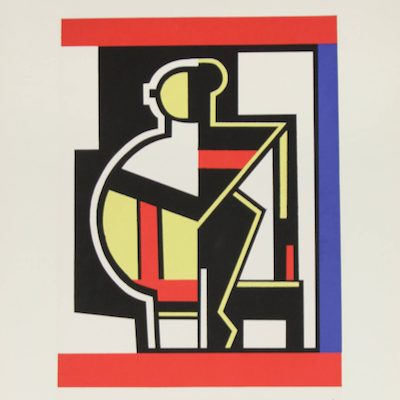
Details
Artist
Styles
Etching and aquatint in colours, on BFK Rives paper, with full margins. - This work is from the UNITÉ book, which began to be printed in 1963 and ended on October 15, 1965 in Paris. - I. 41.5 x 31.5 cm (16 3/8 x 12 3/8 in.) - S. 57 x 45.2 cm (22 1/2 x 17 3/4 in.) - Signed and numbered in pencil, from the edition of 130 pc + 30 in Roman numerals, published by Atelier Crommelynck, Paris // Le Corbusier’s Unité 10 (1963-1965) is a limited-edition etching and aquatint in colors, printed on BFK Rives paper. The composition presents an abstract arrangement of shapes and forms, characterized by bold black outlines filled with vibrant colors such as red, pink, brown, and yellow. The upper half features organic, flowing shapes, contrasted with more solid, block-like figures in the lower half. The use of geometric forms alongside curvilinear elements creates a dynamic contrast, evoking themes of human and architectural interplay. The composition is complex, yet harmonious, reflecting Le Corbusier’s interest in the coexistence of natural forms and structural design.
Unité 10, 1963-1965
form
Medium
Size
57 x 45.2 cm
- Inches
- Centimeters
Edition
Price
- USD
- EUR
- GBP
Details
Artist
Styles
Etching and aquatint in colours, on BFK Rives paper, with full margins. - This work is from the UNITÉ book, which began to be printed in 1963 and ended on October 15, 1965 in Paris. - I. 41.5 x 31.5 cm (16 3/8 x 12 3/8 in.) - S. 57 x 45.2 cm (22 1/2 x 17 3/4 in.) - Signed and numbered in pencil, from the edition of 130 pc + 30 in Roman numerals, published by Atelier Crommelynck, Paris // Le Corbusier’s Unité 10 (1963-1965) is a limited-edition etching and aquatint in colors, printed on BFK Rives paper. The composition presents an abstract arrangement of shapes and forms, characterized by bold black outlines filled with vibrant colors such as red, pink, brown, and yellow. The upper half features organic, flowing shapes, contrasted with more solid, block-like figures in the lower half. The use of geometric forms alongside curvilinear elements creates a dynamic contrast, evoking themes of human and architectural interplay. The composition is complex, yet harmonious, reflecting Le Corbusier’s interest in the coexistence of natural forms and structural design.
- Recently Added
- Price (low-high )
- Price (high-low )
- Year (low-high )
- Year (high-low )
What is Cubism?
Cubism is an art movement that aimed to depict multiple perspectives of objects or figures within a single picture. Artists Georges Braque and Pablo Picasso pioneered this style around 1907. The name Cubism emerged from their use of geometric shapes and outlines that often resembled cubes, breaking objects down into abstracted forms.






























